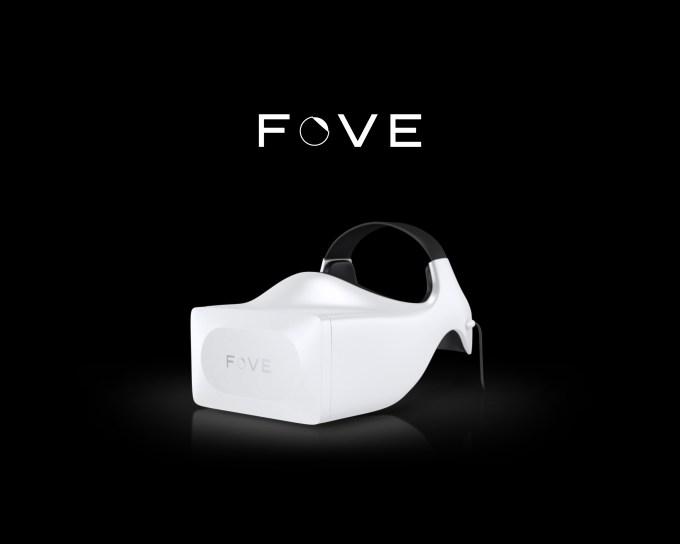FOVE wants to ramp up by the virtual reality experience by creating the world’s first consumer-oriented headmount display to use eye tracking. The Tokyo-based startup was founded by CEO Yuka Kojima and CTO Lochlainn Wilson and is launching today on the Disrupt SF stage.
Fove’s name comes from the words “field of view” and “fovea,” or the part of the eye that is responsible for sharp central vision. The headmount combines eye tracking technology, orientation sensing, and head position tracking so users can control the 360-degree display using only their eyes. FOVE’s virtual world looks different from other virtual reality systems, which have entire scenes in sharp focus, by replicating the depth of field you see in the real world. It does this by tracking the users’ gaze and determining where in 3D space he or she is looking. Then its graphics engine adjusts focus.

The headmount display’s technology makes it possible for users to do things like make eye contact with characters in games or aim weapons much more quickly than with a mouse or keyboard. By the time a FOVE user has reacted to another character, they are already aiming at it.
The founders currently can’t dwelve into too much detail about exactly how FOVE’s technology works because it is patent pending, but the headmount display uses unobtrusive infrared eye tracking technology that can track eye movements with very low latency and high precision.
“The magic here is that we do this in a way that does not interfere with field of view in anyway and is invisible to the user,” said Wilson.
FOVE’s potential competitors include virtual reality headsets like the Oculus Rift and Sony’s Project Morpheus, but Kojima and Wilson say FOVE won’t necessarily take market share away from those products. Instead, the startup wants to expand the market that Oculus Rift opened up and give people an Iron Man J.A.R.V.I.S.-like experience in their living rooms. FOVE’s founders are aiming for gamers who are willing to pay a higher price for a headset for a more immersive experience.
The startup is currently participating in Microsoft Ventures Accelerator London program and will talk to Microsoft about potentially integrating FOVE into Xbox, but there are no concrete plans yet. Wilson notes that pricing may be a challenge, because gamers are usually reluctant to buy an accessory that costs more than a console, and FOVE doesn’t yet know what the final price of its headmounted display will be.
But FOVE isn’t just for gamers. It can also help people with limited mobility because of ALS, motor neuron disease, or spinal cord injuries by serving as a user interface for functions such as typing, gaming, or playing musical instruments. Researchers at universities in Japan are currently studying how FOVE can be used to benefit people with limited motor control or help treat conditions like autism. In addition, FOVE is working with a London company to make interactive wearables that can respond to eye movements and will allow quadriplegics to look around without help from other people.
FOVE can help people with conditions like Aspergers and autism, who often have trouble making eye contact with other people, by creating characters they can interact with in a non-threatening environment.
FOVE is currently in the advanced prototyping stage, with multiple proofs of concept, and the startup is currently developing a manufacturable prototype. Next year, the company plans to launch a Kickstarter campaign and SDK for game developers, and then hopefully make a consumer version of FOVE available for sale by 2016. The company has already secured angel funding from investors in Japan and plans to seek seed investment soon.
[gallery ids="1056386,1056385,1056384,1056383,1056382"]
Q: How do you plan to develop games? There’s a chicken and egg problem because you won’t have a huge customer base and a lot of games.
A: We believe that the tech is quite inspiring. We can bring Iron Man JARVIS-type technology right into your living room. We want to inspire people and developers.
Q: What is the biggest technical limitation outside your control in this field?
A: There’s not a lot that’s really out of our control in this field. We’ve got the eyetracker software working. We just need to get the head position tracking right and that’s just a matter of time.
Q: So the main thing will be about convincing developers to integrate?
A: Yes, when it comes to the gaming ecosystem we plan to market our product to gamers by playing on the inspiration and coolness factor of what we do. And it’s not just games, we are working with researchers in Japan to bring eye tracking to people with mobility issues and disorders like ALS.
Q: How much will FOVE cost?
A: It’ll be slightly more expensive than Oculus Rift because ours is a better experience and we also have a slightly higher hardware cost.
Q: What will your hardware margins be at scale?
A: We’ll have fairly good margins. We’ve got good suppliers in Japan, excellent hardware suppliers, and they are giving us good prices.
Q: 10 to 30 percent or something like that?
A: Higher than that.